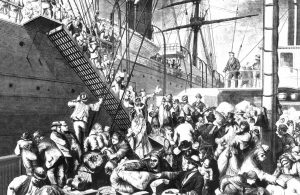1980 American History is dominated by science and other interesting facts.
On April 12, 1981 – The first launch of the Space Shuttle from Cape Canaveral and the Kennedy Space Center occurs as Columbia begins its STS-1 mission. The Space Shuttle is the first reusable spacecraft to be flown into orbit, and it returned to earth for a traditional touchdown landing two days later.
Science and technology made terrific strides in the eighties. Large numbers of Americans began using personal computers in their homes, offices, and schools. Columbia, America’s first reusable spacecraft was launched in 1981. A sad day in our history was January 28, 1986, when space shuttle Challenger exploded 74 seconds after liftoff at Cape Canaveral, Florida killing all seven astronauts, including schoolteacher Christa McAuliffe.

1980s American lifestyles
Perhaps the product that introduced the greatest change in American lifestyles of the 1980s was the PERSONAL COMPUTER. Introduced by APPLE in 1977, the personal computer allowed management of personal finances, quick word-processing, and desktop publishing from the home. Businesses could manage payroll, mailing lists, and inventories from one the small machine. Gone were the ledgers of the past.
1980 American History Summary
The eruption of Mt. St. Helens in 1980 was the worst volcanic disaster in U.S. history; however, it offered scientists an exceptional opportunity to examine and study a large volcanic eruption, which has enriched scientific knowledge of volcanoes.
First Woman Appointed to the U.S. Supreme Court (1981): On July 7, 1981, President Ronald Reagan nominated Sandra Day O’Connor to be the first woman on the U.S. Supreme Court. On September 21, the United States Senate confirmed O’Connor in a vote of 99 for and zero against. Sandra Day O’Connor was officially sworn in and took her seat on the U.S. Supreme Court on September 25, 1981.
On November 9, 1989 – The Berlin Wall, after thirty-eight years of restricting traffic between the East and West German sides of the city, begins to crumble when German citizens are allowed to travel freely between East and West Germany for the first time. One day later, the influx of crowds around and onto the wall begin to dismantle it, thus ending its existence.
At the beginning of the 1980s, various reports began to emerge in California and New York of a small number of men who had been diagnosed with rare forms of cancer and/or pneumonia. Cancer, Kaposi ‘s sarcoma, normally only affected elderly men of Mediterranean or Jewish heritage and young adult African men.
Pneumonia, Pneumocystis Pneumonia Carinii (PCP), is generally only found in individuals with seriously compromised immune systems. However, the men were young and had previously been in relatively good health. The only other characteristic that connected them was that they were all gay.
From the outset, AIDS was associated with a high level of stigma and discrimination. This prejudice arose in part because AIDS was linked to groups, such as gay men and intravenous drug users, that were already highly stigmatized, but also because evidence-based information about what was causing AIDS, and how it might be passed on, was in short supply. See what happened in earlier dacade 1970s.